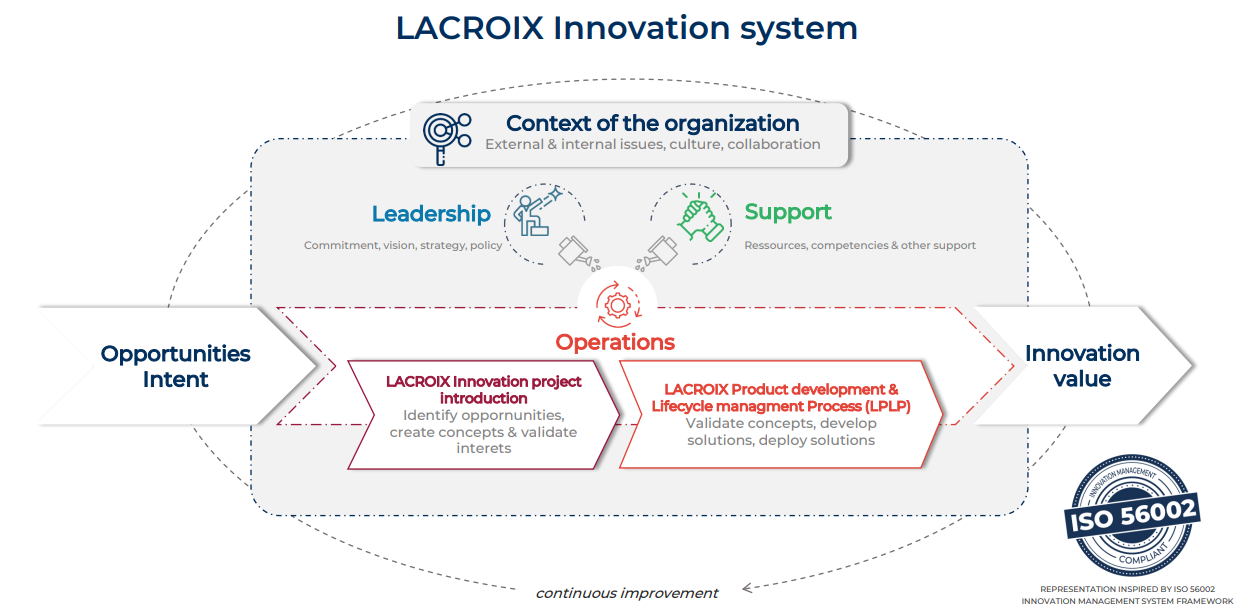21 April 2023
LACROIX
Innovation: new or modified entity realizing or redistributing value.
Structuring innovation within an organization
Innovation is essential for the development and survival of companies, as it allows them to maintain their competitiveness on the market and stimulate economic growth.
Indeed, innovation contributes to the growth of the company by strengthening its position on its existing market or on new markets, differentiating itself from its competitors, improving loyalty or attracting new customers.
In addition, the adoption of innovative practices and techniques can help reduce production costs, improve the quality of products or services, or streamline business processes.
However, innovation should not be seen as an end in itself, but as a means to meet the needs of its customers as well as a way to detect market trends and developments. It must be centered around value creation for stakeholders and should respond to latent market needs rather than focusing only on technology. Investing in R&D as well as in the development of its employees to encourage creativity and innovation are also key points.
The ultimate goal of innovation is to bring progress and make life easier for users, so that they can focus on creating value elsewhere.
The role of the ISO 56000 standard
For the organization to be in working order and oriented towards value creation objectives, an Innovation Management System can be set up, with the help of innovative solutions. The normative reference for this implementation is the ISO 56000 standard.
The ISO 56000 standard is an essential guide for innovation management. It is part of the category of “Management System” standards, just like ISO 9000 for Quality Management, ISO 14000 for Environmental Management and ISO 27000 for Information Security Management. More specifically, it is an Innovation Management System standard.
This standard is a unified document that aims to explain to everyone how Innovation Management works and promote good practices in this field. It offers many benefits to those who wish to implement Management System standards. The ISO 56000 standard was developed by industry experts, with Alice de Casanove, Chair of the ISO 56000 technical committee and Director of Culture and Intrapreneurship at Airbus North America. It is therefore the result of collaboration between professionals in the field, making it a practical guide, rather than a restrictive standard. The ISO 56000 standard also guides the establishment of innovation strategy in organizations, providing a solid reference for building a guided and effective strategy.
Overall, this standard is detailed and provides tools, vocabulary and best practices that can help organizations improve their innovation management. In short, it is a valuable resource for anyone looking to make progress in this area.
Supporting organizations in their innovation process
The ISO 56000 standard is designed to help organizations structure and/or improve their innovation process and innovation management.
This standard offers a comprehensive approach to innovation that applies to all types of organizations, whether they are associations, companies or public institutions.
By adopting the ISO 56000 standard, companies can ensure that innovative products are developed through an integrated approach to innovation at all levels of the organization, creating opportunities for development. In addition, it also provides a system for managing the people, processes and technologies involved in innovation.
A major advantage of the ISO 56000 standard is its ability to be adapted to the corporate culture. This facilitates the appropriation of the elements of the standard and the implementation of an effective innovation process. Also, the standard encourages continuous improvement.
Finally, the standard is a best practice guide that provides recommendations and suggestions, rather than requirements. This allows organizations to better understand their strengths and weaknesses, and then define clear and practical improvement paths.
The use of the ISO 56000 standard at LACROIX
For the implementation of its Innovation Management System, LACROIX relies essentially on ISO 56000 (Essential principles and vocabulary) and ISO 56002 (Innovation management system – Recommendations).
This structure meets the need to standardize internal processes for R&D and Marketing teams spread over 9 sites in France, Spain, Germany and Belgium. To achieve this, operations must be rigorous and processes must be identical for everyone in the Group.
To ensure that innovation processes interact in an optimal way, the ISO 56000 standard establishes a link between the different departments involved. It takes into account key aspects such as context, leadership, improvement, planning, performance, operational and support to ensure that innovation results are positive and that the company progresses towards its objectives.
At LACROIX, we have broken down operations (turning opportunities into value) into two distinct processes. On one hand, innovation projects with a very exploratory component aiming at identifying opportunities, creating concepts and validating interests… and on the other hand, the part aiming at validating concepts, developing solutions and deploying them is organized according to the LPLP (LACROIX Product development & Lifecycle management Process).

To deliver these operations, leadership is essential. It must focus on the vision and strategic plan, the technology and product roadmap, and policy. It is also important to understand and master the context of the organization, including the competition, stakeholders, internal and external collaboration, and the culture of the organization. The Leadership 2025 strategic plan is the reference for the innovation strategy.

At LACROIX, we started with an inventory of the processes in place and were able to observe that there were already a certain number of initiatives linked to innovation (in support processes as well as in operations). We used the ISO 56002 as a reference guide to integrate, adapt or improve these initiatives. We also created the missing processes in order to articulate them between them for an optimal functioning. For a better understanding of the stakeholders, we mapped these processes and detailed them on the Innovation portal, making them accessible to all group employees.”
A differentiating advantage for innovation
The use of the ISO 56000 standard reinforces our reliability with our partners and arouses the interest of other companies. This standard allows us to :
- Create value,
- Transform opportunities and intentions into innovation values,
- Increase our flexibility,
- Improve our performance and efficiency,
- Structure our innovation process,
- Continuously improve our practices,
- Increase our ability to grow and our profitability.
The ISO standard is reassuring for people who are used to well-structured management systems. It brings additional credibility and proves the seriousness of innovative initiatives to our ecosystem.
By providing guidance on the “why” and “how” of innovation, it provides orientations and priorities with a clear vision and organizes actions so that they go in the same direction. It thus contributes to the development of a culture of innovation and enables the company to be more innovative.Thus, thanks to continuous improvement, we can continue catalyzing innovation, promoting our innovation capacities and stimulate collective creativity.
At LACROIX, the ISO 56000 standard provides us with a unique framework to structure our innovation management. It also facilitates the integration of newcomers, thanks to unified supports and documents accessible to all.

LACROIX has proved to be a perfect match for the spirit of the Innovation Team Best Practices, of which I have identified three key areas: awareness of a rapidly changing world and the emergence of new challenges, confidence-building through a set of skills linked to a solid network, and initiative-taking as a springboard for innovation and the human development of companies.”
Plus d'articles

Explained
How to effectively deploy Smart Grids in Spain?

Explained
Computer Vision: turning images into information

Expert's take
What is EV Charging?

Explained
Electric mobility and green hydrogen for a sustainable future

Explained
Digital technology to power the energy revolution

Explained

